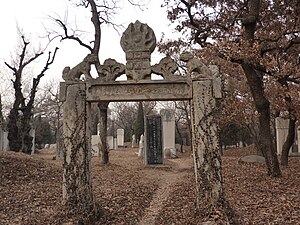Kampanye anti-keagamaan di Tiongkok: Perbedaan antara revisi
←Membuat halaman berisi 'thumb|300px|[[Pemakaman Konghucu diserang oleh Garda Merah pada November 1966.<ref name="Asiaweek, Volume 10">{{cite book|url=https://books.google.com/books?id=dIMMAQAAMAAJ&q=cemetery+Tan+Houlan|title=Asiaweek, Volume 10|publisher=|year=1984|access-date=2017-09-03|archive-date=2016-04-27|archive-url=https://web.archive.org/web/20160427051328/https://books.google.com/books?id=dIMMAQAAMAAJ&q=cemetery+Tan+Houlan|ur...' |
(Tidak ada perbedaan)
|
Revisi per 28 Juli 2021 03.10


Kampanye anti-keagamaan di Tiongkok merujuk kepada promosi resmi ateisme negara oleh Partai Komunis Tiongkok, dipasangkan dengan penindasan orang-orang dengan keyakinan spiritual atau keagamaan, di Republik Rakyat Tiongkok.[3][4][5] Kampanye anti-keagamaan dimulai pada 1949, setelah Revolusi Komunis Tiongkok, dan terjadi pada Buddhis, Kristen, Muslim, dan komunitas agama lainnya pada abad ke-21.[6] Kampanye-kampanye melawan keagamaan meningkat sejak Xi Jinping menjadi Sekretaris Jenderal Partai Komunis Tiongkok.[7] Untuk Kristen, dekrit-dekrit pemerintah memandatkan penghancuran rumah-rumah ibadah, seperti gereja-gereja Kristen.[8] Di Tibet, dekrit serupa memandatkan penghancuran pusat-pusat monastik Buddhis Tibetan, situs-situs suci Buddhis, kediaman-kediaman monastik dan penolakan terhadap hak oranh Tibet untuk bebas mengakses warisan budaya mereka dan menimbilkan penindasan tekrini terhadap lama-lama Buddhis tingkat tinggi serta biksu dan biksuni Buddhis. Laporan kamp reedukasi paksa, penangkapan, penghajaran, pemerkosaan dan penghancuran situs-situs keagamaan di Tibet dilakukan seperti halnya kepada orang Uighur, yang diduga juga menjadi subyek dari genosida kebudayaan saat ini.
Referensi
- ^ Asiaweek, Volume 10. 1984. Diarsipkan dari versi asli tanggal 2016-04-27. Diakses tanggal 2017-09-03.
- ^ Jeni Hung (April 5, 2003). "Children of confucius". The Spectator. Diarsipkan dari versi asli tanggal March 21, 2006. Diakses tanggal 2007-03-04.
- ^ Blondeau, Anne-Marie; Buffetrille, Katia (8 April 2008). Authenticating Tibet
 (dalam bahasa English). University of California Press. hlm. 165. ISBN 9780520249288.
(dalam bahasa English). University of California Press. hlm. 165. ISBN 9780520249288. This virulent anti-religion campaign seems to be officially linked to the development plan for western Tibet, for which social stability is necessary (see Part VIII, "Economic Development," below). But the hardening of this policy in Tibet is probably also a consequence to spread atheism launched in China, in response to the religious problems mentioned above, including problems inside the Party.
- ^ Dark, K. R. (2000), "Large-Scale Religious Change and World Politics", Religion and International Relations (dalam bahasa Inggris), London: Palgrave Macmillan UK, hlm. 50–82, doi:10.1057/9781403916594_3, ISBN 978-1-349-27846-6,
Interestingly, atheist campaigns were most effective against traditional Chinese religions and Buddhism, whereas Christian, Jewish and Muslim communities not only survived these campaigns, but were among the most vocal of the political opposition to the governments as a consequence of them.
- ^ "China announces "civilizing" atheism drive in Tibet". BBC Online (dalam bahasa English). 12 January 1999. Diarsipkan dari versi asli tanggal 4 September 2017. Diakses tanggal 3 September 2017.
The Chinese Communist Party has launched a three-year drive to promote atheism in the Buddhist region of Tibet, saying it is the key to economic progress and a weapon against separatism as typified by the exiled Tibetan leader, the Dalai Lama. The move comes amid fresh foreign reports of religious persecution in the region, which was invaded by China in 1950.
- ^ Johnson, Ian (April 23, 2017). "In China, Unregistered Churches Are Driving a Religious Revolution". The Atlantic. Diarsipkan dari versi asli tanggal September 4, 2017. Diakses tanggal September 9, 2020.
It’s hardly celebrated here at all,” he said. “We had this break in our history—you know, the missionaries being expelled in 1949 and then the anti-religious campaigns—so a lot has been lost. A lot of people don’t really know too much about Lent. We had a service trying to reintroduce the idea and explain it.
- ^ "China's war on religion". The Week. August 23, 2020. Diakses tanggal September 20, 2020.
- ^ "China's anti-Christian crusade". The Washington Post (dalam bahasa English). 5 September 2015. Diarsipkan dari versi asli tanggal 7 September 2017. Diakses tanggal 3 September 2017.
The profusion of churches seems to have unnerved some Chinese authorities, who have undertaken a campaign to tear down hundreds of crosses, and in some instances entire churches, in Zhejiang, a coastal province where a prosperous Christian community and large numbers of churches have taken root.
